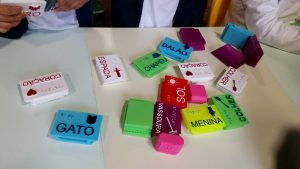
University students Giulia Pereira (Graphic Design) and Vitor Akamine (Mechanical Engineering) designed and developed a toy that aims to integrate children with visual impairment (low or no vision) with children with no disability. Called TOGOTOY, the toy was designed in 3D with Autodesk Fusion 360 software.
TOGO in Japanese means integration and so this was the name chosen for the project.
According to Vitor, using Autodesk’s 3D modeling software was essential to transform the idea into a real object and thus give rise to the first prototype of the product. The student had contact with the tool through a course given by Autodesk in his college.
“Fusion 360 is easy to handle and revolutionary software because it lets you make anything. In addition, designing with the cloud made it much easier to develop TOGOTOY, because of the fast file integration,” explains the student who took advantage of the free time between classes to dedicate himself to the project and always used different University computers.
“It was very practical to be able to work with this flexibility,” says Vitor.
The idea of TOGOTOY arose during a design course’s final project to develop a toy. And the question of how to make it more accessible for children with disabilities became apparent.
“This motivation boosted the start of the project. In the meantime, we encountered several obstacles in the production of the product, since we had no practical experience in developing something innovative. From then on, we used modeling and 3D printing,” says Giulia.
Currently, there are few inclusive toys on the market, mostly made by hand. TOGOTOY is one of the first toys designed for industrial manufacturing.
“Autodesk aims to make people use tools to make anything, whether it be complex infrastructure construction or a toy that connects children. Our mission is to be a way to make that happen,” said Greg Eden, Autodesk Vice President of Brand and Communication.
How it works
TOGOTOY is composed of rectangular modular blocks that connect by simple fittings and, when connected, form a hexagonal tower.
On the outer surface of each block, there are three stimuli for children: words written in the Braille alphabet, their transcriptions in the usual alphabet, plus the corresponding symbol of the word – the last two in relief. Added to the strong contrast of colors between the background and elements of the play, the toy allows both visually impaired children (total or partial) and seers to play together and create their own stories, any way they want.
The TOGOTOY dynamic consists in building a free story created through imagination. At the end of the assembly, the children construct a structure that tells the story the way they chose.
All the sensory elements in the toy are being carefully chosen to stimulate as much creativity as possible.
Next Steps
TOGOTOY is already in its fourth prototype and the product evolves every day. Students are working in partnership with the Dorina Nowill Foundation’s innovation industry to enhance the toy. In addition, students seek partnership for large-scale production. The project has already been presented at various events in Brazil and abroad.

(0)